December itinerary in Japan Day 3 (Aomori Day 3)
(Monday, December 13th)
Table of contents
1. Saishoin Five-storied Pagoda
2. Kimura Industrial Research Institute
7. Former Fujita Family Residence (Dazai Osamu Manabi no Ie)
1. Saishoin Five-storied Pagoda
The third day of my trip to Aomori and Akita was heavy snow from the morning. Even so, I decided to visit as many sightseeing spots as possible, so I went to the “Saishoin Five-storied Pagoda” near my hotel. The “Saishōin Five-storied Pagoda” was completed in 1667. It is said that it was built as a memorial service for enemies and allies who died in the process of unifying Tsugaru by clan ancestor, Tamenobu Tsugaru in Hirosaki Domain (Tsugaru Domain) .
As a five-storied pagoda, it is a national important cultural property of the northernmost in Japan. It is said to be the most beautiful tower in the Tohoku region. It was very beautiful with snow.
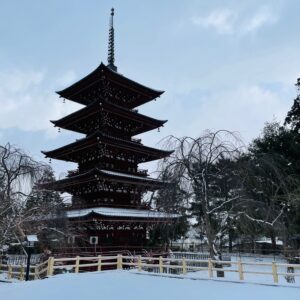
The precincts were also quiet and had a solemn atmosphere in the snow.
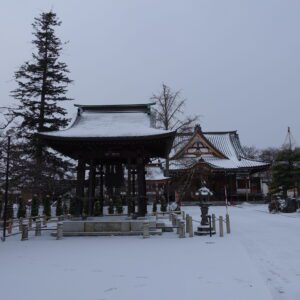
2. Kimura Industrial Research Institute
There was “Kimura Industrial Research Institute” on the way from “Saishoin Five-storied Pagoda” to “Choshoji”. This is the first building that architect Kunio Maekawa studied under Le Corbusier and worked on after returning to Japan. It is said to be the oldest modernist architecture in Japan. It was designated as a national important cultural property in 2021. However, I couldn’t understand its goodness.
Kunio Maekawa’s masterpieces include the Tokyo Bunka Kaikan and the Tokyo Metropolitan Art Museum in Ueno Park, Tokyo.
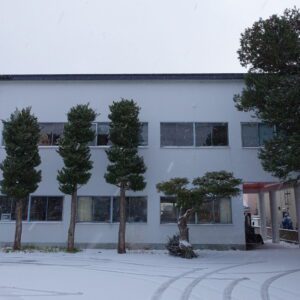
3. Sazaedo
There is “Sazaedo” in the middle of Zenringai heading to Choshoji Temple. It was built in 1839. In the hall, a clockwise corridor and a straight staircase are used together, and 33 Kannon and 100 Kannon are arranged. There are only two Sazaedo temples in the Tohoku region (the other is the former Sazaedo Temple Sankodo in Aizuwakamatsu, a national important cultural property). It is a tangible cultural property of Hirosaki City.
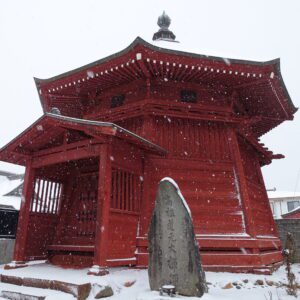
4. Kuromon
There is “Kuromon” in the immediate vicinity of Sazaedo. “Kuromon” is the front gate of Zenringai as the gate of Choshoji Temple. It is a tangible cultural property of Hirosaki City.
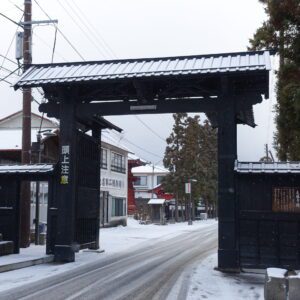
5. Choshoji Temple
There is “Choshoji Temple” in the innermost part of Zenringai. “Choshoji” is a temple of the Soto sect and is a family temple of the Tsugaru clan, the lord of the Hirosaki domain. Sanmon, Mikagedo, Main Hall, Kuri, Tsugaru Family Tamaya, and Bronze Bell are national important cultural properties.
In particular, Sanmon, which was built in 1629, was a wonderful force. After all, I love Zen Buddhism Sanmon.
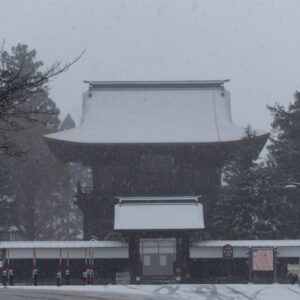
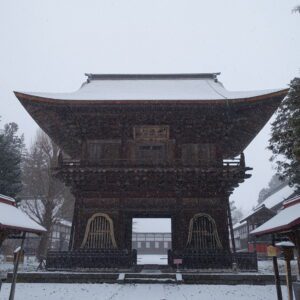
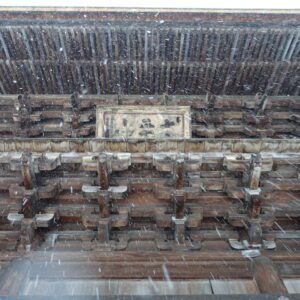
In addition to the main hall, the back of the warehouse, and the bronze bell, there were 500 Rakans of Soryu Cave in the precincts. It was hard to walk in the snow, but the snowy scenery of “Choshoji” was all wonderful. It was my greatest happiness to be surrounded by wonderful buildings in the precincts of the empty fresh snow.

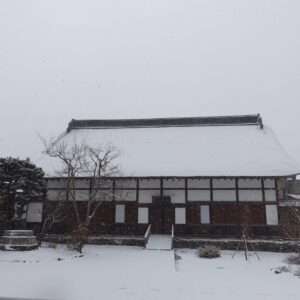
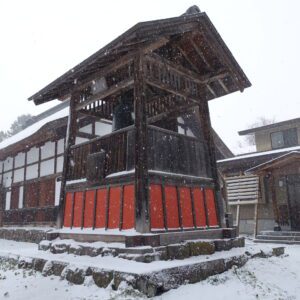
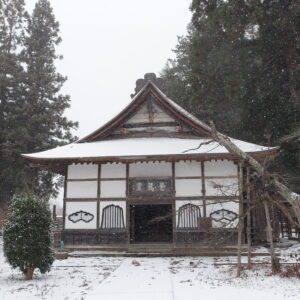
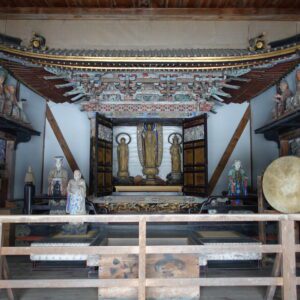
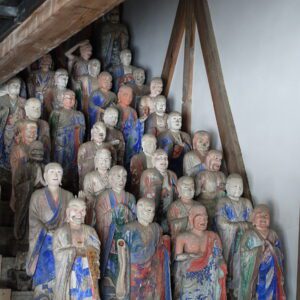
6. Former Kaikousha Building
After lunch, I walked in the snowstorm and went to “Former Kaikousha Building”. “Former Kaikousha Building” was built in 1907 in Hirosaki City as a meeting place and social gathering place for former Army officers. It is a national important cultural property. As I posted on the BLOG on January 13, the designer is Sakichi Horie, who designed the Aomori Bank Memorial Museum. It is a wooden one-story building with a wide structure of 48.8m for the east and west girders. The width was so wide that I couldn’t take a picture of the entire building without a wide-angle lens.
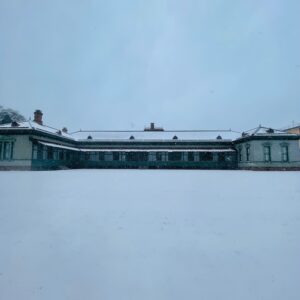
Reservations are required, but you can tour the inside of the “Former Kaikousha Building”. Guided is once a day from 12:00 to about 40 minutes. The tour fee is Yen 500 per person. You can also tour without a guide from 9:00 to 16:00. The tour fee is Yen 300 per person. I didn’t have time to tour the interior.
7. Former Fujita Family Residence (Dazai Osamu Manabi no Ie)
Next to “Former Kaikousha Building”, there is “Former Fujita Family Residence (Dazai Osamu Manabi no Ie)”. This is the house where Osamu Dazai (Shuji Tsushima) spent three years in the old high school days from 1927 to 1930. The Fujita family is a relative of the Tsushima family. The Former Fujita Family Residence is also the house where Osamu Dazai attempted suicide for the first time in his life.
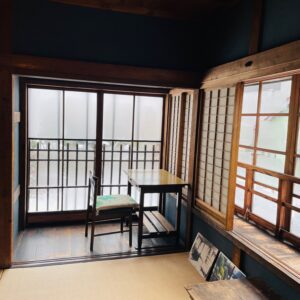
The room where Osamu Dazai (Shuji Tsushima) lived and the desk he used are left as they are. The Former Fujita Family Residence is designated as a tangible cultural property of Hirosaki City.
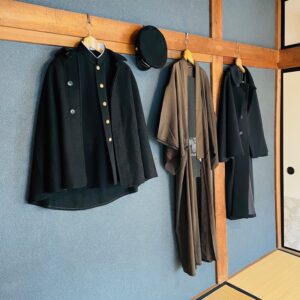
8. Tsugaru-han Neputa Village
After “Former Fujita Family Residence (Dazai Osamu Manabi no Ie)”, I went to “Tsugaru-han Neputa Village” by bus. Hirosaki City is a city that can be visited on foot around Hirosaki Park, but the “Former Fujita Family Residence (Dazai Osamu Manabi no Ie)” and “Former Kaikousha Building” are a little far apart. It was snowing, so I decided to go to “Tsugaru-han Neputa Village” by bus.

In Hirosaki City, the “Dotemachi Circulation Bus” that goes around Hirosaki Park from Hirosaki Station runs for a fare of Yen 100. The bus runs every 10 minutes, making it a very convenient bus for travelers. To get to “Tsugaru-han Neputa Village”, get off at “Cultural Center Mae” and walk for about 5 minutes. From April to November, a bus called “Tamenobu-go” runs for a fare of Yen 100, and it is even more convenient because there is a “Neputa Village” bus stop.

Hirosaki Neputa is designated as a national important intangible folk cultural property. There is no clear reason for the difference between “Neputa” such as Hirosaki City and “Nebuta” such as Aomori City. The colloquial language is “neputa” and the literary language is “nebuta”, which means that even Aomori citizens often speak “neputa”.
The difference between “Hirosaki Neputa” and “Aomori Neputa” seems to be that the fan-shaped lantern with a neputa picture is “Hirosaki Neputa” and the horizontally long three-dimensional doll lantern is “Aomori Nebuta”. The first photo of the next photo is “Hirosaki Neputa” and the second one is “Aomori Nebuta”.


In addition to these two types, there is also “Tachineputa” in Goshogawara City, which produces doll lanterns that are tall in the vertical direction. Depending on the region, the “Neputa” festivals held in various parts of Aomori Prefecture include fan-shaped lanterns like Hirosaki, horizontally long doll lanterns like Aomori City, and vertical doll lanterns like Goshogawara City. We are holding a festival.
I have to regret on “Hirosaki Neputa”. When I was advised to go to “Tsugaru-han Neputa Village” at the Hirosaki City Tourist Information Center at Hirosaki Station, I said, “I went to Nebuta House Wa Rasse in Aomori City, so I already saw Nebuta.” The tourist information center said “Aomori Nebuta and Hirosaki Neputa are completely different”, but I thought it wouldn’t make much difference. I am very sorry to have trampled on the pride of the festivals in each region.
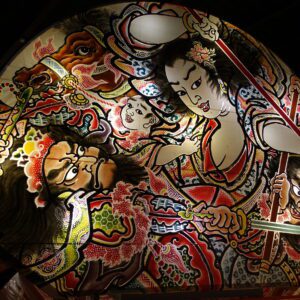
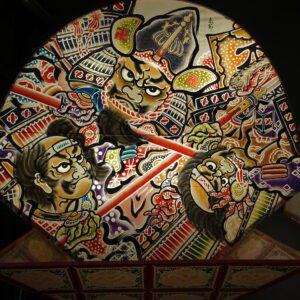
The origin of the “Neputa Festival” is the Toro nagashi held at the Tanabata Festival. It is said that “Hirosaki Neputa”, where the Hirosaki Domain Office was located, was the first of the “Neputa Festival”.
In “Tsugaru-han Neputa Village”, cute “Goldfish Neputa”, Maneki Neko, and 2022 Zodiac Tiger Neputa were also exhibited.
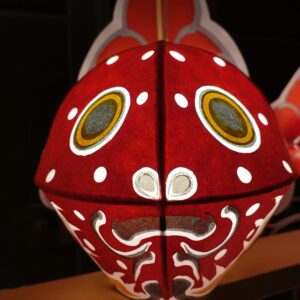
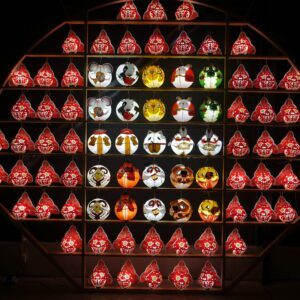
You can also listen to live Tsugaru shamisen music every day. On the day I visited, I heard a wonderful performance by Chikako Fukushi, a master.
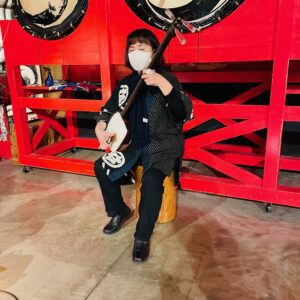
In “Tsugaru-han Neputa Village”, there is a Japanese garden “Yokien” which is designated as a national registered monument. I couldn’t visit because of the snowstorm on the day of my visit.
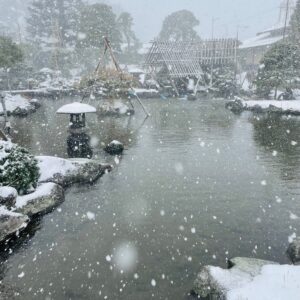
Admission: Adults Yen 550, high and junior high school students Yen 350, elementary school students Yen 220
I took the “Dotemachi Circulation Bus” from “Tsugaru-han Neputa Village” to Hirosaki Station. After that, I went to Akita station. Originally, I wanted to go by limited express, but due to the influence of snow, the limited express was suspended and I had no choice but to go to Akita station by local train. The trains I used are as follows.
Depart Hirosaki Station at 14:48, JR Ou Line bound for Akita, arrive at Akita Station at 17:22, fare Yen 2,640
The limited express fare is Yen 4,000, higher than the local train Yen 2,640, but you will arrive at Akita almost 30 minutes earlier.
Note: The departure / arrival times, fares, admission fees, meal fees, etc. of transportation listed in the text are as of the time of writing the BLOG. Please check for yourself when you go on a trip as it may change in the future.